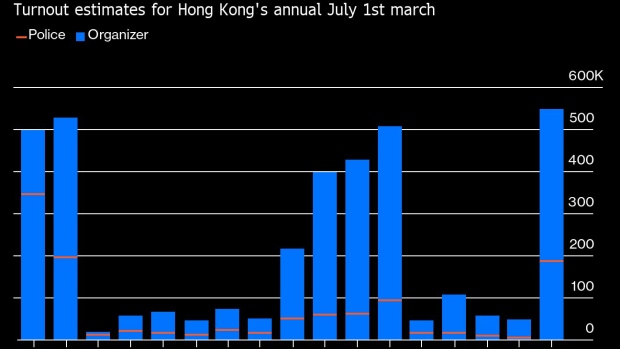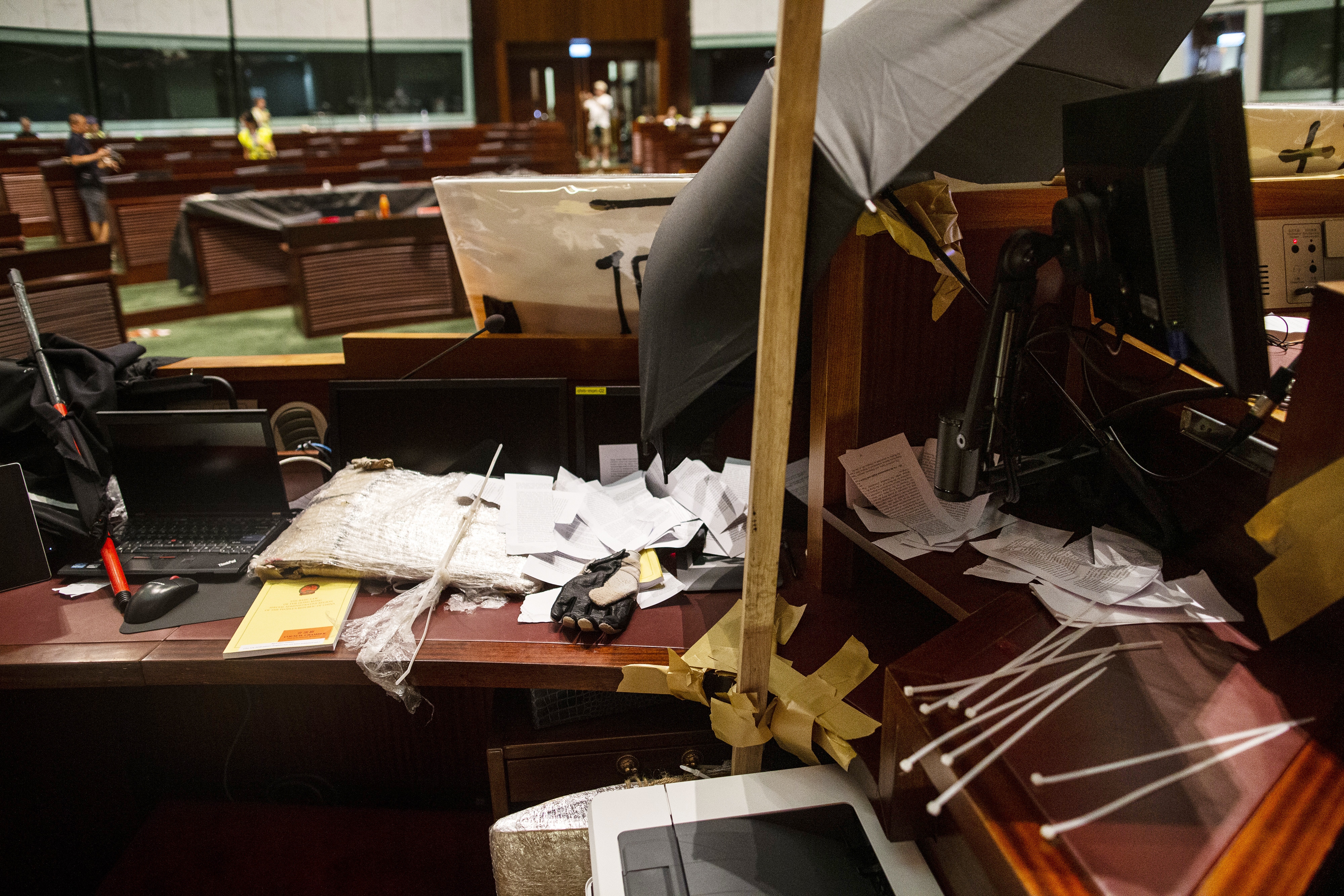Jul 2, 2019
Hong Kong protesters on edge after historic night of vandalism, tear gas
, Bloomberg News
Hong Kong Protesters Vandalize City Legislature
Hong Kong began picking up after historic protests left the legislature ransacked, the streets littered with spent tear gas canisters and the city’s Beijing-backed leader promising to push back against further unrest.
Chief Executive Carrie Lam used a dramatic 4 a.m. news conference to condemn the “extreme use of violence and vandalism” and defend the police’s decision to withdraw and leave the Legislative Council to a small but destructive group of protesters. Most of the violence was over by 1 a.m., after the last crowds of mask- and helmet-wearing demonstrators fled the area to escape hundreds of riot police firing tear gas. As of 1 p.m., there was no indication from police that any protesters had been arrested.
Legislative Council President Andrew Leung, on site to assess the damage, said the remaining two meetings of the legislature before its summer recess in July had been called off after extensive damage, effectively canceling the remainder of this year’s session.
“The police are now gathering evidence in the complex,” he said. “The repair and the rebuilding of the LegCo complex is expected to take a long time.”
Opposition lawmaker Claudia Mo said that while Hong Kong’s pan-democratic politicians didn’t approve of the ransacking, Lam was twisting Monday’s events to cast the protesters in a bad light.
“Of course, we do not endorse vandalism, we don’t condone violence, but we hope everyone, not just in Hong Kong but in the whole wide world will try to understand the Hong Kong youngsters, the desperation exhibited behind the so-called violent act,” she told reporters. “Carrie Lam is trying to turn the table and trying to shift public opinion, focusing on our youngsters.”

City Reopens
As of 9:30 a.m., authorities had reopened most of the streets around the central government complex in Admiralty and crews were clearing discarded umbrellas and plastic wrap that protesters had used to defend themselves from pepper spray. The legislative building will require a lengthier cleanup after demonstrators pulled down portraits, spray-painted slogans and draped a Union Jack-emblazoned colonial flag across the body president’s desk.
Lam, who has seen her popularity plunge to record lows amid weeks of unprecedented protests, seized on the destruction to call for a return to order.
“This is something that we should seriously condemn because nothing is more important than the rule of law in Hong Kong,” she said. “I hope community at large will agree with us that, with these violent acts that we have seen, it is right for us to condemn it and hope society will return to normal as soon as possible.”
Eddie Chu, a pro-democracy lawmaker and member of Hong Kong’s Legislative Council, said Lam had not addressed what her administration would do to address the crises.
“Ninety-nine percent is about the condemnation of the protesters, but very little time was left for how the government is going to resolve this crisis,” he told Bloomberg Television of her speech, speaking outside the legislature. “I think in the coming weeks we will see a very large hit back from the Beijing side and it turn into a security issue.”
The defacement of the only democratically elected legislature under Beijing control came on the anniversary of the former British colony’s return to Chinese rule. After an annual flag-raising ceremony that also marked the start of her third year in office, Lam promised to win back the public’s trust by governing in a more inclusive way.

Beijing Embarrassed
The Hang Seng Index climbed 1.3 per cent at 1:09 pm local time as the city’s market reopened after a holiday, catching up with a global rally on trade talk optimism. The Hong Kong dollar briefly traded in the stronger half of its band against the greenback for the first time since September, rising as much as 0.18per cet to 7.7995.
Lam’s government sparked the worst political crisis since the 1997 handover because of her decision to push legislation that would for the first time allow extraditions to China, a move that alarmed both locals and multinational companies. The clashes have embarrassed the central government in Beijing, which continues to back Lam’s administration.
China referred to protesters at the legislature as “extremists” and said it supported Hong Kong in punishing anyone responsible for the damage, the official Xinhua News Agency reported, citing a spokesman from the Hong Kong and Macau Affairs Office of the State Council.
The violence trampled on Hong Kong’s legal system, disrupted social order and defied the “one country, two systems” framework of governance in the city, the spokesman said.
At her early morning news conference, Lam denied that her government hasn’t responded to the people’s demands, pointing to a mid-June announcement that the extradition bill would be suspended. But some protesters have vowed to fight until she withdraws the bill completely and resigns.
“This is simply very unfortunate situation that we cannot find a way to make the government respond,” Fernando Cheung, vice chairman of the pro-democracy Labour Party, told reporters while protesters wrecked the chambers. He described the police’s decision to withdraw as a trap to discredit the opposition, saying “this is exactly what the government wants.”
Even as chaos unfolded, one of the largest crowds ever -- between 190,000 and 550,000 people -- marched largely without incident in the annual July 1 protest. While opposition lawmakers joined the government in condemning the attack on the legislative chamber, they blamed authorities for ignoring their demands despite several peaceful demonstrations in recent weeks.
Similar pleas earlier in the day failed to stop protesters from smashing their way through glass entryways surrounding the legislative complex. Crowds gathered around the building throughout the day, as police repeatedly fell back without attempting to clear the streets.
Hong Kong Police Commissioner Stephen Lo said early Tuesday police retreated out of fear for the safety of bystanders and themselves after protesters backed them into the building, tampered with the electrical boxes and threw “toxic powder” at officers.
The day began under a cloud of violence, as riot police used pepper spray and batons to push back protesters ahead of Lam’s remarks at the annual flag-raising ceremony. The demonstrators were attempting to disrupt the event at the Hong Kong Convention and Exhibition Center in Wan Chai.
Lam had earlier in the day promised to work harder “to get the pulse of the society. I have learned that even with good intentions, I have to be open and inclusive.”
Police previously unleashed tear gas and rubber bullets after a group of protesters, some throwing bricks and other projectiles, unsuccessfully attempted to storm the Legislative Council on June 12. Since then, the demonstrators have demanded that the government drop prosecution against arrested protesters and rescind its characterization of the earlier incident as a “riot situation.”
Earlier: Fresh Hong Kong Protests Signal Gridlock Facing Lam’s Government
Apart from the protesters who stormed the legislature, thousands of people on Monday marched peacefully in the afternoon from centrally located Victoria Park through the city’s financial core in opposition to Lam’s administration.
--With assistance from Fion Li, Sophie Kamaruddin, Stuart Biggs, Sebastian Chau, Edith Moy, Natalie Lung, Simon Lee, Bill Faries, Larry Liebert, Dominic Lau, Jon Herskovitz, Qi Ding and Kari Lindberg.









